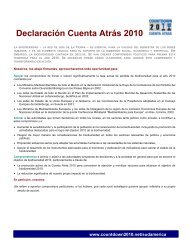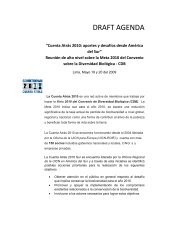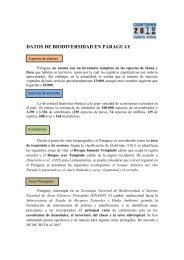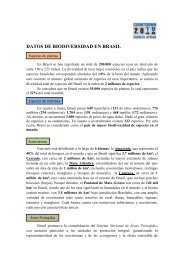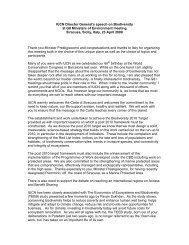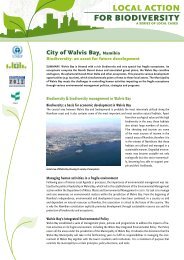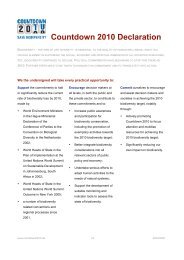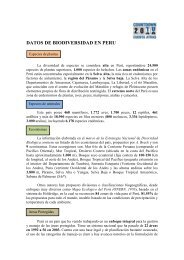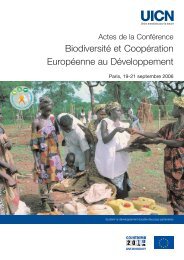COUNTDOWN 2010 READINESS ASSESSMENT FRANCE ...
COUNTDOWN 2010 READINESS ASSESSMENT FRANCE ...
COUNTDOWN 2010 READINESS ASSESSMENT FRANCE ...
You also want an ePaper? Increase the reach of your titles
YUMPU automatically turns print PDFs into web optimized ePapers that Google loves.
<strong>COUNTDOWN</strong> <strong>2010</strong> <strong>READINESS</strong> <strong>ASSESSMENT</strong><br />
<strong>FRANCE</strong><br />
preliminary desk study<br />
1
<strong>COUNTDOWN</strong> <strong>2010</strong> <strong>READINESS</strong> <strong>ASSESSMENT</strong><br />
<strong>FRANCE</strong><br />
preliminary desk study<br />
Contents<br />
Introduction.................................................................................................................................................................3<br />
Existing national environmental policy and legislation .......................................................................................................3<br />
National targets for the conservation of genetic biodiversity........................................................................................................3<br />
Information on bathing water quality..........................................................................................................................................4<br />
Restoration programmes .........................................................................................................................................................4<br />
Action Plans and conservation status of marine species and habitats.........................................................................................4<br />
Invasive Alien Species legislation in place .................................................................................................................................4<br />
Bio-safety measures to reduce impacts from alien genotypes....................................................................................................4<br />
Trade in CITES species............................................................................................................................................................4<br />
Plans and follow up of the UN Millennium Ecosystem Assessment.............................................................................................5<br />
Integration of biodiversity into cross-sector policies .........................................................................................................5<br />
Integration of biodiversity considerations into development programmes, and projects’ impact on biodiversity...............................5<br />
Implementation of the Integrated Coastal Zone Management concept ........................................................................................5<br />
Application of the Ecosystem approach to the management of fisheries .....................................................................................5<br />
Biodiversity considerations in aquaculture .................................................................................................................................5<br />
Adaptation measures to increase biodiversity resilience to climate change..................................................................................5<br />
Stakeholder awareness and participation .......................................................................................................................6<br />
Integration of biodiversity into public policy/wider decision making..............................................................................................6<br />
National partnerships for biodiversity (including private sector involvement)..................................................................................6<br />
National/sub-national public awareness campaigns/initiatives ....................................................................................................6<br />
Implementation of Multilateral agreements relevant to biodiversity conservation ..................................................................6<br />
Ratified Biodiversity-related agreements (year) ...........................................................................................................................6<br />
Paid contributions....................................................................................................................................................................7<br />
Financial and technical resources for achieving the <strong>2010</strong> target .......................................................................................7<br />
Proportion of its Rural Development budget allocated to biodiversity...........................................................................................7<br />
Funding for biodiversity under the national research programmes...............................................................................................7<br />
Annual funding for biodiversity..................................................................................................................................................7<br />
Funds provided for biodiversity activities in developing countries ................................................................................................7<br />
Existence of a national set of biodiversity indicators ...................................................................................................................8<br />
Sources......................................................................................................................................................................8<br />
2
<strong>COUNTDOWN</strong> <strong>2010</strong> <strong>READINESS</strong> <strong>ASSESSMENT</strong><br />
<strong>FRANCE</strong><br />
preliminary desk study<br />
Competent authorities for nature &<br />
biodiversity:<br />
Ministère de l’Ecologie, de l’Énergie, du<br />
Développement durable et de l’Aménagement<br />
du territoire (MEDAD)<br />
http://www.developpement-durable.gouv.fr/<br />
Most recent national/sub-national<br />
biodiversity strategy/action plan:<br />
Stratégie Française pour la Biodiversité (2004)<br />
http://www.environnement.gouv.fr/IMG/pdf/s<br />
nb.pdf<br />
Latest review of the implementation of<br />
the biodiversity strategy/action plan:<br />
Stratégie nationale pour la biodiversité : rapport<br />
d’activité 2006<br />
http://www.ecologie.gouv.fr/IMG/pdf/SNBrapport-activite-2006.pdf<br />
Introduction<br />
France is located in Western Europe, although its territory also<br />
comprises various overseas islands and territories located in<br />
other continents. Its total land area, with its overseas<br />
departments and territories (excluding Adélie Land), is<br />
674,843 square kilometres (260,558 sq mi), or 0.45% of the<br />
total land area on Earth. With an estimated population of 64.5<br />
million people, France is the 19th most populous country in the<br />
world.<br />
France (excluding its overseas territories) comprises 40% of<br />
Europe’s flora. This flora is characterized by a high rate of<br />
endemism, especially in the Mediterranean and Pyrenees<br />
mountains. Threatened species in France’s fauna account for<br />
39% of reptiles, 36% of mammals, and 22% of freshwater fish<br />
species. In addition, the country comprises 276 species of<br />
birds, of which 18% are threatened.<br />
Overseas, the territories, although considerably smaller in area,<br />
are home to 100 times more freshwater fish species, 60 times<br />
more endemic birds, 26 times more endemic plants, and 3.5<br />
times more endemic molluscs. Some examples of this lush<br />
biodiversity can be found in French Guyana, with a vast track of<br />
untouched primary Amazonian forest, over 5350 species of<br />
vascular plants, and 183 terrestrial mammals; and New<br />
Caledonia, an overseas territory with its own government<br />
responsible for the protection of biodiversity, an 85% endemic<br />
flora, with several families and genus found no where else in<br />
the world, as well as half of the species of coniferous plants<br />
found in the southern hemisphere.<br />
In 2005, zones that were dedicated to the conservation of<br />
biodiversity accounted for 12.6% of all of the French territory.<br />
Today, the destruction, fragmentation and alteration of habitats<br />
constitute the most important direct cause of the decline of<br />
biodiversity in the country.<br />
Existing national environmental policy and legislation<br />
The French National Strategy for Biodiversity was developed in<br />
2004. It has 3 main objectives, namely:<br />
• To protect habitats and ecosystem diversity, species and<br />
genetic diversity,<br />
• To maintain and develop a web of natural areas over the<br />
territory, and<br />
• To ensure the maintenance of ecosystem health and<br />
functions.<br />
National targets for the conservation of genetic biodiversity<br />
Since the 1990s France has taken actions to maintain<br />
threatened plant varieties and breeds of domestic animals. Its<br />
national targets for the conservation of genetic diversity are in<br />
accordance with those of the CBD, and include the promotion<br />
of quality products (which often use local varieties) such as<br />
through the Appellation d’Origine Contrôlée and Indication<br />
3
<strong>COUNTDOWN</strong> <strong>2010</strong> <strong>READINESS</strong> <strong>ASSESSMENT</strong><br />
<strong>FRANCE</strong><br />
preliminary desk study<br />
géographique d’origine certification schemes.<br />
Furthermore, France has incorporated a number of Good<br />
Agricultural Environmental Conditions (GAEC) that may provide<br />
significant biodiversity conservation benefits. These include<br />
rules for the maintenance of pasture, with locally defined criteria<br />
based on stocking densities, or an obligation to graze or mow.<br />
There are also measures to maintain cultivated crop diversity,<br />
but there are no measures to maintain important landscape<br />
features.<br />
where practicable, marine areas which have been adversely<br />
affected, in accordance with the provisions of this Convention.<br />
France is also a contracting party to the Barcelona Convention<br />
and therefore has responsibilities under the Mediterranean<br />
Action Plan and the Strategic Action Plan for Protection of<br />
Biological Diversity in the Mediterranean Region.<br />
Invasive Alien Species legislation in place<br />
Information on bathing water quality<br />
France has a specific website dedicated to bathing waters:<br />
http://baignades.sante.gouv.fr/ where the public can access<br />
reports and real-time information on bathing water.<br />
Invasive Alien Species (IAS) are partly covered under the<br />
Natural Heritage Plan of the French Strategy for biodiversity and<br />
within hunting and wild-fauna programmes. Present-day France<br />
does not count with an overarching IAS legislation in place,<br />
although regulations exist for IAS trade-related issues and<br />
intentional introduction.<br />
Restoration programmes<br />
The French Marine Action Plan indicates that it is necessary to<br />
develop restoration plans for threatened species such as<br />
turtles, cetaceans and sturgeons (some of which are currently<br />
being launched). Furthermore, there is a conservation plan<br />
approved by the French National Nature Conservation Council<br />
(CNPN) for Ospreys (Pandion haliaetus).<br />
The French ministry of Ecology, Sustainable Development and<br />
Spatial Planning (MEDAD) is currently working on measures to<br />
address IAS within biodiversity action plans, and the French<br />
government recently launched a biodiversity programme<br />
dealing with IAS.<br />
Bio-safety measures to reduce impacts from alien<br />
genotypes<br />
Within the Context of the Mediterranean Action Plan of the<br />
Barcelona Convention, France has adopted Action Plans for<br />
Mediterranean species of marine turtles, monk seal, cetaceans<br />
(especially bottle-nose dolphin), sea birds (such as Audouin’s<br />
gull), cartilaginous fishes (such as the great white shark), and<br />
marine plants. These Action Plans contain objectives relating to<br />
the elaboration and setting up monitoring programmes and<br />
monitoring networks for the species in question.<br />
Action Plans and conservation status of marine species and<br />
habitats<br />
Several regulations are in place in relation to the deliberate<br />
release of Genetically Modified Organisms (GMOs) in the<br />
framework of France's Environmental Code, including plants,<br />
animals and phyto-pharmaceutical products.<br />
France is also an implementing Party to the Cartagena Protocol<br />
on Biosafety. Furthermore, it must implement relevant legislation<br />
based on European Union's provisions for GMOs. However, in<br />
2004 and 2007 the European Court of Justice ruled that<br />
France did not comply to transpose the EU directive on the<br />
deliberate release into the environment of GMOs 1 .<br />
Developed in 2005, the French Marine Action Plan for<br />
Biodiversity incorporates an strategy for ICZM and actions to<br />
incorporate biodiversity issues into national, European and<br />
international policies and plans.<br />
Trade in CITES species<br />
France is a party to the Convention on the International Trade of<br />
Endangered Species (CITES), and as such must report on the<br />
As a contracting party of the OSPAR convention, France<br />
implements the ‘Biological Diversity and Ecosystems’ strategy,<br />
with the objective to protect and conserve the ecosystems and<br />
the biological diversity of the maritime area which are, or could<br />
be, affected as a result of human activities, and to restore,<br />
1<br />
2001/18 EEC<br />
4
<strong>COUNTDOWN</strong> <strong>2010</strong> <strong>READINESS</strong> <strong>ASSESSMENT</strong><br />
<strong>FRANCE</strong><br />
preliminary desk study<br />
amount of trade in CITES species. France is a major player in<br />
the international trade of CITES species, mirrored in the large<br />
number of CITES certificates issued and the number of seized<br />
items.<br />
The information available did not contain data on denied permit<br />
applications or total figure for seizures, although details on the<br />
seizures are presented, varying substantially between years.<br />
National capacity building for CITES implementation focuses on<br />
improving networks, hiring of staff, computerisation, as well as<br />
advice, assistance and training provided for the Management<br />
Authority, the Scientific Authority, the Enforcement Authorities<br />
and traders.<br />
Plans and follow up of the UN Millennium Ecosystem<br />
Assessment<br />
questions that determine the need to conduct a detailed<br />
assessment study. The study is financed by the French<br />
Development Fund, or by other donors in co-funded projects,<br />
with the participation of qualified local consultants in recipient<br />
countries. At the time of this study, it was unclear to what<br />
extend these assessments are mandatory and biodiversity<br />
considerations integrated.<br />
Implementation of the Integrated Coastal Zone<br />
Management concept<br />
An overall strategy for Integrated Coastal Zone Management<br />
(ICZM) is included within the French Marine Plan of Action.<br />
Under this strategy France aims to develop ICZM actions, new<br />
coastal policies based on ICZM principles and indicators in line<br />
with marine and coastal biodiversity indicators. France has<br />
provided good examples of new coordination mechanisms<br />
involving various stakeholders horizontally and vertically in the<br />
implementation of ICZM strategies at the European level.<br />
France is currently developing a plan to follow up the<br />
Millennium Ecosystem Assessment, in which a number of<br />
different systems and ecosystems services will be included.<br />
Such a plan will be focused at the national level, with some<br />
elements of specific interest addressed at the sub-national<br />
level.<br />
The planning process is in its initial phase, were systems,<br />
sources, and valuation methods are still being specified. This<br />
Plan is expected to continue until mid-2009.<br />
Integration of biodiversity into cross-sector policies<br />
Integration of biodiversity considerations into development<br />
programmes, and projects’ impact on biodiversity<br />
Although there are relevant guidance documents available for<br />
public forests, afforestation schemes and projects in France,<br />
these are not subject to Strategic Environmental Assessment<br />
(SEA) or Environmental Impact Assessment (EIA) procedures.<br />
Planning regulations and EIAs are required however for<br />
deforestation proposals of more than 10 ha.<br />
In 2006 France intended to start implementing ICZM activities<br />
by establishing a National Council for the Coast with the<br />
responsibility for integrated coastal management.<br />
Application of the Ecosystem approach to the management<br />
of fisheries<br />
France published a plan for fisheries in 2006, in which an<br />
integrated approach combining objectives related to resources,<br />
energy and value-added, although it does not specifically<br />
mention the ecosystem based approach to management.<br />
Furthermore, the French Marine Action plan recognises the<br />
need to integrate the protection of biodiversity into the<br />
objectives of the Regional Fisheries Organisations.<br />
Biodiversity considerations in aquaculture<br />
The French Fisheries Operational programme includes in one of<br />
its axis an objective to develop methods of aquaculture that<br />
maintain water quality and promote the protection of<br />
biodiversity.<br />
Furthermore, France applies an environmental assessment<br />
process at an early stage in development co-operation projects<br />
and at a level appropriate to the type of project, the significance<br />
of the potential environmental impacts and the socio-cultural<br />
and biophysical sensitivity of the environment.<br />
Impact significance is assessed through a series of test<br />
Adaptation measures to increase biodiversity resilience to<br />
climate change<br />
The French National Biodiversity Strategy notes the impacts of<br />
climate change on biodiversity and promotes the maintenance<br />
of connectivity (e.g. through corridors). Furthermore, France<br />
5
<strong>COUNTDOWN</strong> <strong>2010</strong> <strong>READINESS</strong> <strong>ASSESSMENT</strong><br />
<strong>FRANCE</strong><br />
preliminary desk study<br />
has produced a climate change adaptation strategy, although it<br />
has not defined targets for increasing the resilience of<br />
biodiversity to climate change in accordance with CBD goals.<br />
From the information available at the time of this study, it is not<br />
clear if a strategy or programme of defined actions to facilitate<br />
biodiversity adaptation exists.<br />
Stakeholder awareness and participation<br />
Integration of biodiversity into public policy/wider decision<br />
making<br />
The integration of biodiversity into public policy is one of the<br />
objectives in France’s National Biodiversity Strategy. This is also<br />
one of the major objectives of the European Union Biodiversity<br />
Action Plan. By the time of this study, no information on<br />
concrete examples of such a practice was found.<br />
National partnerships for biodiversity (including private<br />
sector involvement)<br />
France has in place national initiatives to promote partnerships<br />
for biodiversity in a series of sectors, including: Tourism, Mining,<br />
Farming/Forestry, Small and Medium Enterprises (SMEs),<br />
Energy and Infrastructure. Furthermore, there are also guidance<br />
documents for partnerships between businesses and Natura<br />
2000 sites.<br />
National/sub-national public awareness<br />
campaigns/initiatives<br />
The information available hints to the fact that a large share of<br />
public biodiversity awareness campaigns focus on the Natura<br />
2000 Network. Since 1993 a number of documents have been<br />
published to increase public awareness of the Natura 2000<br />
network. These includes leaflets, brochures, newsletters,<br />
guidance documents (covering forests, coasts, wetlands, agropastoral<br />
habitats, rocky habitats, plant species and animal<br />
species). Furthermore, a dedicated Natura 2000 website was<br />
launched in December 2000 (http://www.natura2000.fr/.<br />
Implementation of Multilateral agreements relevant to biodiversity conservation<br />
The achievement of the <strong>2010</strong> Biodiversity target is partly dependent on the effective implementation of biodiversity commitments. The<br />
2006 Global Biodiversity Outlook report reveals that while much progress has been made in developing policy and tools for<br />
implementing Multilateral Environmental Agreements (MEAs), national-level implementation has been limited and lacks behind.<br />
Ratified Biodiversity-related agreements (year)<br />
CBD CITES RAMSAR CMS WHC ITPGR UNFCCC UNCCD<br />
1994 1978 1986 1990 1987 2005 1994 1997<br />
6
<strong>COUNTDOWN</strong> <strong>2010</strong> <strong>READINESS</strong> <strong>ASSESSMENT</strong><br />
<strong>FRANCE</strong><br />
preliminary desk study<br />
Paid contributions<br />
UNEP Environment Fund CBD CITES RAMSAR CMS WHC<br />
$4,340,000.0 (2007) $663,515<br />
(2008)<br />
$294,287 (2008) CHF 360,458<br />
(2008)<br />
€331,954<br />
(2008)<br />
$198,828* (2008)<br />
• this is the expected contribution for 2008, although it had not been received by the time this study was completed<br />
Financial and technical resources for achieving the<br />
<strong>2010</strong> target<br />
Funds provided for biodiversity activities in developing<br />
countries<br />
Proportion of its Rural Development budget allocated to<br />
biodiversity<br />
A relatively small proportion of the budget of the French<br />
Regional Development Programme is allocated to biodiversity.<br />
According to its Rural Development Programme for 2007-2013<br />
only 15.1% of the French RDP budget is allocated to<br />
biodiversity-related measures, amounting to 1,641.6 million<br />
Euro (excluding additional private & national contributions.).<br />
Funding for biodiversity under the national research<br />
programmes<br />
Funding for biodiversity from the French National Research<br />
Agency (ANR) has been estimated approximately to EUR 10<br />
million per year since 2005.. In 2008, the total allocation<br />
(MEDAD) towards environmental research was EUR 1,335<br />
millions, of which approximately 0.75% were dedicated to<br />
biodiversity.<br />
However, this represents only a very small part of the total<br />
environmental research budget for the whole of France, as<br />
these values do not include funds allocated by the French<br />
Ministry of Research as well as from various research<br />
organisations.<br />
Funds provided by France for biodiversity activities in<br />
developing countries are jointly managed by the Ministry of<br />
Foreign Affairs (MAE) and the Ministry of Economic Affairs,<br />
Finance and Industry (MINEFI), whi have joint responsibility of<br />
the management ODA. The French Development Agency (AFD)<br />
acts as the principal operator.<br />
Annual spending on biodiversity-related bilateral aid 2 in 2005<br />
was EUR 12 million, amounting to 0.2% of the total bilateral aid<br />
budget.<br />
Overseas Countries and Territories (OCTs) have a special<br />
status and benefit from thematic programmes financed by the<br />
Development Cooperation Financing Instrument (DCFI). In the<br />
case of France, biodiversity-related aid to OCTs is mainly<br />
channeled via the Ministry of Overseas Affairs, and provided by<br />
ministerial credits, the AFD and public funds, with a strong<br />
focus on economic and social development of those territories.<br />
The overall amount of annual spending on biodiversity-related<br />
bilateral external assistance for France's OCTs could not be<br />
estimated.<br />
Annual funding for biodiversity<br />
Annual national funding for biodiversity activities amounted to<br />
EUR 900 million in 2002.<br />
2<br />
Biodiversity-related aid is defined as activities that promote<br />
at least one of the three objectives of the Convention on Biological<br />
Diversity: the conservation of biodiversity, sustainable use of its<br />
components (ecosystems, species or genetic resources), and the fair<br />
and equitable distribution of the benefits of the utilization of genetic<br />
resources.<br />
7
<strong>COUNTDOWN</strong> <strong>2010</strong> <strong>READINESS</strong> <strong>ASSESSMENT</strong><br />
<strong>FRANCE</strong><br />
preliminary desk study<br />
Existence of a national set of biodiversity indicators<br />
France has developed a detailed set of biodiversity indicators<br />
for Metropolitan and Overseas France, closely related aspects<br />
of the set of CBD focal areas and the corresponding European<br />
Union's headline indicators.<br />
These indicators cover, amongst others, features such as<br />
genetic diversity, bird's diversity, diversity/richness of fisheries,<br />
status of Red-list species, habitat's diversity, and ecological<br />
zones.<br />
Sources<br />
CBD website http://www.cbd.int/countries/country=fr<br />
CBD National Reports<br />
Wikipedia: http://en.wikipedia.org/wiki/France<br />
CITES<br />
http://www.cites.org/eng/resources/reports/biennial.shtml<br />
http://www.cites.org/eng/cop/14/doc/E14-07-1.pdf<br />
French National Biodiversity Strategy<br />
http://www.ecologie.gouv.fr/IMG/pdf/Biodiversite_complet-<br />
2.pdf.<br />
Third National Report to the CBD<br />
http://www.cbd.int/doc/world/fr/fr-nr-03-fr.doc<br />
French Ministry of Agriculture and Fisheries<br />
http://agriculture.gouv.fr/<br />
GMO information site http://www.ogm.gouv.fr/<br />
Case C-121/07 http://eur-lex.europa.eu/<br />
National Report on the Cartagena Protocol on Biosafety<br />
http://www.cbd.int/biosafety/parties/reports.shtmlreport=NR-<br />
CPB-01<br />
OECD<br />
http://www.oecd.org/document/11/0,3343,en_2649_34603_<br />
32070731_1_1_1_1,00&&en-USS_01DBC.html<br />
Environmental Assessment Summary Sheets: Bilateral and<br />
Multilateral Development Agencies http://www.acdicida.gc.ca/CIDAWEB/acdicida.nsf/En/REN-218131217-PEH<br />
Biennial Reports of CITES Parties<br />
http://www.cites.org/eng/resources/reports/biennial.shtml<br />
ANR http://www.agence-nationale-recherche.fr/<br />
Global Biodiversity Outlook http://www.cbd.int/gbo2/<br />
The publication was produced with the financial support of the<br />
European Commission.<br />
8



